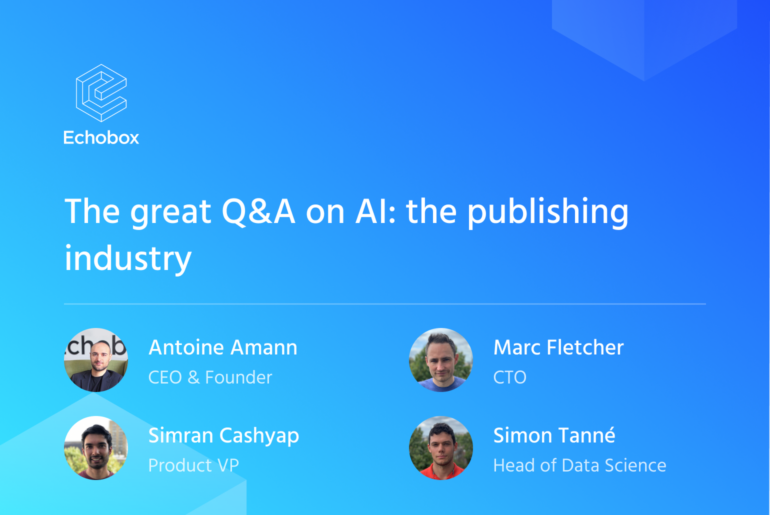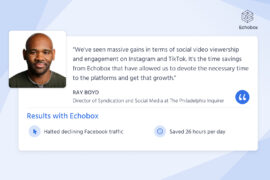We’re back with part 2 of our Q&A on everything AI with our experts. If you’ve missed it, you can read part 1 here.
Having innovated and operated at the intersection of tech and publishing for years, our experts are well-placed to explain what generative AI really means. Today, we’ll delve into how Echobox trains datasets and discuss how publishers can use AI safely.
We sat down with:
- Simon Tanné, our Head of Data Science since 2014
- Dr. Marc Fletcher, CTO since 2013
- Simran Cashyap, our VP of Product since 2019
- Antoine Amann, founder and CEO
Echobox is celebrating its 10th anniversary this year. Over the last decade, how has the publishing and media industry adapted to these technologies? Did publishers need convincing to adopt AI at first?

Antoine (CEO): We started Echobox in 2013 with the vision to help publishers use AI to automate the newsroom. Back then, the concept of automation didn’t really exist in publishing and we were amongst the first to articulate the impact of AI in the media industry. Today, automation and AI are hot topics at the forefront of everyone’s minds. Our 2023 Publishing Trends Survey made this crystal clear: 94% of our respondents find AI and automation important to their organization.
We were lucky at Echobox. We had the foresight to realize how important AI would become, and we’ve had a big headstart when it comes to news automation. Echobox Social, our first product, is the leader in social media automation and optimization. We strongly believe no other product comes close in terms of technology and results.
It wasn’t always easy convincing publishers to adopt AI, and some were wary of giving away power to algorithms. At the end of the day, the numbers speak for themselves. Our clients were motivated by the performance gains Echobox provides, and automation became increasingly prevalent in business and accepted by the general public. I’m proud to say that, over time, Echobox became a standard in the industry.
In ten years, we’ve grown to over 100 employees with 2000 publisher clients using Echobox in over 100 countries. This exponential growth allows us to dig deep and never stop questioning what tasks could be improved in the newsroom with automation. We’ll never stop innovating.
How does Echobox train datasets for our generative AI features, such as AI-generated share messages?

Simon (Head of Data Science): Echobox leverages few-shot learning capabilities of models like ChatGPT to generate share messages. Few-shot learning refers to the ability of a machine learning model to understand and start performing a task with just a few examples.
Let’s take the case of our AI-generated share messages. Echobox would provide the model with some examples of successful share messages, as well as an appropriate prompt, and the AI would use those examples to generate new, similar messages. The model has been trained on a very large amount of text data, so it understands the structure and style of the language and can create coherent and relevant messages.
We were lucky at Echobox. We had the foresight to realize how important AI would become, and we’ve had a big headstart when it comes to news automation. – Antoine Amann, co-founder and CEO
In what ways does Echobox apply generative AI to its products? What are some examples of features we’ve developed with this tech?
Simran (VP of Product): We’ve been working with generative AI for years now. Our data scientists were incredibly excited to build on the newer generations of generative AI models and their capabilities. They’ve spent a great deal of effort in making smart, pioneering AI products that simplify and modernize publishers’ workflows.
The first way in which we’ve done this is through our “Inspire me” share message generator on Echobox Social. Using OpenAI’s GPT model, we’ve developed share messages that are tailored to the content and tone of voice of your brand to maximize virality and engagement. It also refines the style based on the past top-performing shares. This ChatGPT-generated share message is now available on Facebook, Twitter and LinkedIn, across 13 different languages.
We’re in the process of developing lots of exciting new innovations, and we’re rolling them out soon. Watch this space!
On the topic of new innovations, are there plans to introduce other types of machine learning and generative AI to Echobox products? What do you imagine that would look like for publisher workflows?
Simran: As an AI-driven company, we are constantly experimenting with the latest innovations in AI. The list of new features and improvements to existing features is monumental. Since we are focused on publishers, particularly saving time and improving performance, we want to make sure that anything we add is well tested and really improves workflows.

For Echobox Email specifically, we’ve got a few huge features currently being refined internally. These include new ways of automatically generating subject lines and preview text.
We’ve also got an amazing innovation we’re very excited about currently in the works. This new feature will leverage AI to automatically generate editorial notes for newsletters based on your content, in your tone of voice. I can’t reveal much more about specific features, but I can tell you how excited we are to make all of these technologies seamless parts of publishers’ workflows.
Our data scientists were incredibly excited to build on the newer generations of generative AI models and their capabilities. – Simran Cashyap, VP of Product
There’s been a lot of talk surrounding AI in journalism and its increasing presence in newsrooms and workflows. How do you see generative AI changing the publishing industry?
Marc (CTO): In my opinion, the most important aspect of journalism is that a reader is left with the understanding and perspective that the publisher originally intended. There are many ways to achieve this. Ensuring topics are presented accurately, representatively and reliably is not something any generative AI will be able to match for the foreseeable future.

Publishers are already severely under-resourced and journalists are often under pressure to deliver content quickly. This can cause the most important aspects of journalism to be compromised, particularly when it comes to complex or nuanced topics. Generative AI and automation free up time so journalists and editors can invest and focus their remaining resources to ensure accurate, representative and reliable reporting.
Many actors in the publishing industry are skeptical about generative AI and the potential threats it could pose to journalistic accuracy and ethics. Although changes to conventional workflows can be expected, there really shouldn’t be anything to fear. The end result will be a more successful publishing industry.
Finally, do you have recommendations on how newsrooms can balance these risks with the vast opportunities?
Simran: There are three recommendations I’d give to anyone using AI in newsrooms.
First, focus on accuracy. Large Language Models (LLMs) can provide incorrect responses. At Echobox, we have refined our usage of these models and added checks to reduce the possibility of inaccurate responses. We recommend manually reviewing all machine generated text, and validating it for correctness.
Second, don’t compromise on your tone of voice. It is vital to make sure that tools are using your style when producing content. Failing to do so can lead to an inconsistent and jarring experience for your readers. At Echobox, we personalize all text generation based on your tone of voice.
Finally, check for biases. All AI models need to be trained on vast amounts of data. If there is an inherent bias – even subtle – within the training data, the model will amplify that bias. Again, reviewing manually is very important.
Ethical AI is a very hot topic at the moment, and with good reason. If you’re interested in learning more, Simon wrote a great piece on the ethical issues companies should be aware of when using AI and how to battle bias.
Generative AI and automation free up time so journalists and editors can invest and focus their remaining resources to ensure accurate, representative and reliable reporting. – Marc Fletcher, CTO
That’s a wrap to the great Q&A on AI. To learn more about Echobox’s artificial intelligence, you can sign up to our newsletter or follow us on LinkedIn, Facebook, and Twitter. We’ve also got great white papers on our latest research on AI for publishers.



